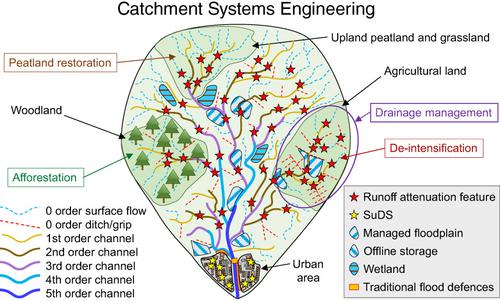当前位置:
X-MOL 学术
›
WIREs Water
›
论文详情
Our official English website, www.x-mol.net, welcomes your feedback! (Note: you will need to create a separate account there.)
Catchment systems engineering: An holistic approach to catchment management
WIREs Water ( IF 8.2 ) Pub Date : 2020-02-17 , DOI: 10.1002/wat2.1417 Caspar J. M. Hewett 1 , Mark E. Wilkinson 2 , Jennine Jonczyk 1 , Paul F. Quinn 1
WIREs Water ( IF 8.2 ) Pub Date : 2020-02-17 , DOI: 10.1002/wat2.1417 Caspar J. M. Hewett 1 , Mark E. Wilkinson 2 , Jennine Jonczyk 1 , Paul F. Quinn 1
Affiliation

|
Hydrological catchments today are largely the product of human activity. They have been engineered. The negative impacts of some of this engineering such as deforestation and agriculture intensification need to be addressed but the solution is not simply a matter of doing the opposite, for example through afforestation or moving to less‐intensive farming. We propose a catchment systems engineering (CSE) approach that utilizes and expands on existing catchment‐based approaches, combining interventions that work with or mimic natural processes with traditional “hard” engineering to provide a practical route to improved catchment function. The approach is predicated on the need to take an holistic view of catchments and to make proactive interventions that provide and enhance multiple ecosystem services. CSE seeks to address problems that are international in scope, recognizing the need to understand better how hydrological processes have changed due to human activity and how those changes influence frequency, duration, and severity of environmental problems such as floods, droughts, and poor water quality. The emphasis is placed on how we can act to engineer catchment systems to a safer functionally appropriate level utilizing measures such as nature‐based solutions alongside traditional engineering structures. CSE is the means to provide multiple ecosystem services while recognizing trade‐offs between reducing flood and drought risk directly, improving water quality and creating healthy habitats for wildlife. By targeting local hydrological flow pathways in defined spatial and temporal windows (e.g., during rainfall events at key locations such as riparian zones), CSE can deliver holistic water resource management now.
中文翻译:

集水系统工程:集水管理的整体方法
今天的水文集水区很大程度上是人类活动的产物。他们已经被设计。需要解决某些工程的负面影响,例如毁林和农业集约化,但是解决方案不只是做相反的事情,例如通过植树造林或改种集约化农业。我们提出了一种集水区系统工程(CSE)方法,该方法利用并扩展了现有的基于集水区的方法,将与自然过程一起工作或模仿自然过程的干预措施与传统的“硬”工程相结合,以提供改善集水区功能的实用途径。该方法的前提是需要全面了解流域并采取主动干预措施,以提供和增强多种生态系统服务。CSE致力于解决国际范围内的问题,认识到有必要更好地了解人类活动导致水文过程如何发生变化,以及这些变化如何影响频率,持续时间和环境问题(例如洪水,干旱和水质差)的严重性。重点放在我们如何采取行动,利用基于自然的解决方案以及传统工程结构等措施,将集水系统工程设计到功能上更安全的适当水平。CSE是提供多种生态系统服务的一种方法,同时可以直接认识到在减少洪水和干旱风险,改善水质和为野生生物创造健康栖息地之间的取舍。通过在定义的时空窗口(例如,
更新日期:2020-02-17
中文翻译:

集水系统工程:集水管理的整体方法
今天的水文集水区很大程度上是人类活动的产物。他们已经被设计。需要解决某些工程的负面影响,例如毁林和农业集约化,但是解决方案不只是做相反的事情,例如通过植树造林或改种集约化农业。我们提出了一种集水区系统工程(CSE)方法,该方法利用并扩展了现有的基于集水区的方法,将与自然过程一起工作或模仿自然过程的干预措施与传统的“硬”工程相结合,以提供改善集水区功能的实用途径。该方法的前提是需要全面了解流域并采取主动干预措施,以提供和增强多种生态系统服务。CSE致力于解决国际范围内的问题,认识到有必要更好地了解人类活动导致水文过程如何发生变化,以及这些变化如何影响频率,持续时间和环境问题(例如洪水,干旱和水质差)的严重性。重点放在我们如何采取行动,利用基于自然的解决方案以及传统工程结构等措施,将集水系统工程设计到功能上更安全的适当水平。CSE是提供多种生态系统服务的一种方法,同时可以直接认识到在减少洪水和干旱风险,改善水质和为野生生物创造健康栖息地之间的取舍。通过在定义的时空窗口(例如,


























 京公网安备 11010802027423号
京公网安备 11010802027423号